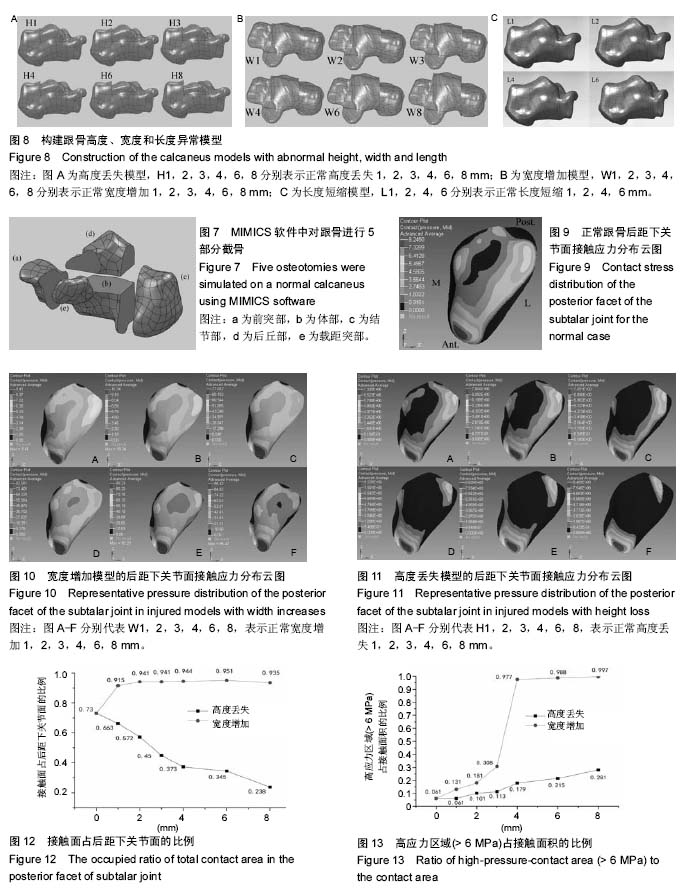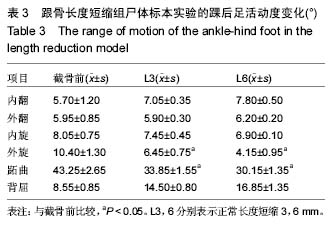中国组织工程研究 ›› 2016, Vol. 20 ›› Issue (46): 6899-6906.doi: 10.3969/j.issn.2095-4344.2016.46.008
• 骨组织构建 bone tissue construction • 上一篇 下一篇
跟骨三维形态学参数与踝后足功能的关系
许 灿,李明清,李康华,刘 华
- 中南大学湘雅医院骨科,湖南省长沙市 410008
Relationship between ankle-hind foot function and calcaneal three-dimensional morphological parameters
Xu Can, Li Ming-qing, Li Kang-hua, Liu Hua
- Department of Orthopaedics, Xiangya Hospital of Central South University, Changsha 410008, Hunan Province, China
摘要:
文章快速阅读:
.jpg) 文题释义:
跟骨形态:跟骨外形复杂,是足部最大的不规则骨。跟骨三维形态学参数包括跟骨高度、宽度、长度以及Gissane角、Bohler角等。跟骨骨折往往伴随着各形态学参数的复杂改变,各形态学参数改变后对踝-后足的功能会产生不同程度的影响。
数值实验:传统生物力学实验通常以人体或动物标本作为实验对象,而数值实验(以三维有限元法为代表)也是骨科生物力学研究的有效手段,可以对许多生物力学指标进行定量分析,在踝足生物力学分析方面有很多成功的先例。三维有限元分析的优势在于可以对载荷,边界条件等参数进行变更,从而模拟各种实验条件。三维有限元法很早就被应用于术前计划和手术疗效的预判,其输出的参数例如肌腱和韧带的应力,接触面积和压力等都极具价值。
文题释义:
跟骨形态:跟骨外形复杂,是足部最大的不规则骨。跟骨三维形态学参数包括跟骨高度、宽度、长度以及Gissane角、Bohler角等。跟骨骨折往往伴随着各形态学参数的复杂改变,各形态学参数改变后对踝-后足的功能会产生不同程度的影响。
数值实验:传统生物力学实验通常以人体或动物标本作为实验对象,而数值实验(以三维有限元法为代表)也是骨科生物力学研究的有效手段,可以对许多生物力学指标进行定量分析,在踝足生物力学分析方面有很多成功的先例。三维有限元分析的优势在于可以对载荷,边界条件等参数进行变更,从而模拟各种实验条件。三维有限元法很早就被应用于术前计划和手术疗效的预判,其输出的参数例如肌腱和韧带的应力,接触面积和压力等都极具价值。
.jpg) 文题释义:
跟骨形态:跟骨外形复杂,是足部最大的不规则骨。跟骨三维形态学参数包括跟骨高度、宽度、长度以及Gissane角、Bohler角等。跟骨骨折往往伴随着各形态学参数的复杂改变,各形态学参数改变后对踝-后足的功能会产生不同程度的影响。
数值实验:传统生物力学实验通常以人体或动物标本作为实验对象,而数值实验(以三维有限元法为代表)也是骨科生物力学研究的有效手段,可以对许多生物力学指标进行定量分析,在踝足生物力学分析方面有很多成功的先例。三维有限元分析的优势在于可以对载荷,边界条件等参数进行变更,从而模拟各种实验条件。三维有限元法很早就被应用于术前计划和手术疗效的预判,其输出的参数例如肌腱和韧带的应力,接触面积和压力等都极具价值。
文题释义:
跟骨形态:跟骨外形复杂,是足部最大的不规则骨。跟骨三维形态学参数包括跟骨高度、宽度、长度以及Gissane角、Bohler角等。跟骨骨折往往伴随着各形态学参数的复杂改变,各形态学参数改变后对踝-后足的功能会产生不同程度的影响。
数值实验:传统生物力学实验通常以人体或动物标本作为实验对象,而数值实验(以三维有限元法为代表)也是骨科生物力学研究的有效手段,可以对许多生物力学指标进行定量分析,在踝足生物力学分析方面有很多成功的先例。三维有限元分析的优势在于可以对载荷,边界条件等参数进行变更,从而模拟各种实验条件。三维有限元法很早就被应用于术前计划和手术疗效的预判,其输出的参数例如肌腱和韧带的应力,接触面积和压力等都极具价值。摘要
背景:跟骨整体形态与后距下关节面解剖对位都是跟骨关节内骨折手术治疗的重要预后因素,但当前仍缺少系统的生物力学实验证实跟骨三维形态学参数对于踝-后足功能的重要性。
目的:综合利用实体实验与数值分析方法,明确跟骨三维形态学参数与踝后足功能的相关性。
方法:首先使用人体踝足尸体标本构建跟骨高度、宽度和长度异常模型,通过生物力学加载支架对各组模型进行加载,分析跟骨高度丢失、宽度增加和长度短缩模型的动力学数据。进而构建正常人体踝后足有限元模型,在其基础上建立跟骨高度丢失、宽度增加和长度短缩数值模型,计算后距下关节面的接触特征。
结果与结论:①跟骨宽度增加和长度短缩会部分限制踝后足的活动度,跟骨高度丢失则会引起距下关节活动度增加;②跟骨宽度增加会增加距下关节的接触面积,高度丢失会减少距下关节的接触面积,并使关节应力中心向关节面前下方移动;③跟骨三维形态学参数的改变会导致踝后足生物力学异常,因此跟骨骨折修复治疗中应当细致恢复跟骨的整体形态。
中国组织工程研究杂志出版内容重点:组织构建;骨细胞;软骨细胞;细胞培养;成纤维细胞;血管内皮细胞;骨质疏松;组织工程
ORCID: 0000-0003-3878-3963(许灿)
中图分类号:



.jpg)
.jpg)
.jpg)
.jpg)
.jpg)
.jpg)
.jpg) 文题释义:
跟骨形态:跟骨外形复杂,是足部最大的不规则骨。跟骨三维形态学参数包括跟骨高度、宽度、长度以及Gissane角、Bohler角等。跟骨骨折往往伴随着各形态学参数的复杂改变,各形态学参数改变后对踝-后足的功能会产生不同程度的影响。
数值实验:传统生物力学实验通常以人体或动物标本作为实验对象,而数值实验(以三维有限元法为代表)也是骨科生物力学研究的有效手段,可以对许多生物力学指标进行定量分析,在踝足生物力学分析方面有很多成功的先例。三维有限元分析的优势在于可以对载荷,边界条件等参数进行变更,从而模拟各种实验条件。三维有限元法很早就被应用于术前计划和手术疗效的预判,其输出的参数例如肌腱和韧带的应力,接触面积和压力等都极具价值。
文题释义:
跟骨形态:跟骨外形复杂,是足部最大的不规则骨。跟骨三维形态学参数包括跟骨高度、宽度、长度以及Gissane角、Bohler角等。跟骨骨折往往伴随着各形态学参数的复杂改变,各形态学参数改变后对踝-后足的功能会产生不同程度的影响。
数值实验:传统生物力学实验通常以人体或动物标本作为实验对象,而数值实验(以三维有限元法为代表)也是骨科生物力学研究的有效手段,可以对许多生物力学指标进行定量分析,在踝足生物力学分析方面有很多成功的先例。三维有限元分析的优势在于可以对载荷,边界条件等参数进行变更,从而模拟各种实验条件。三维有限元法很早就被应用于术前计划和手术疗效的预判,其输出的参数例如肌腱和韧带的应力,接触面积和压力等都极具价值。